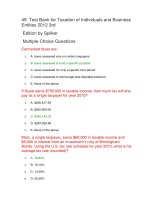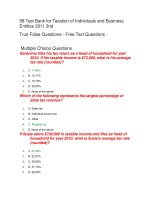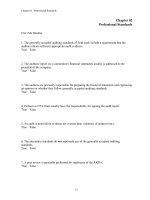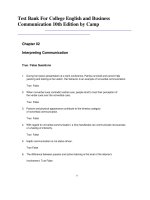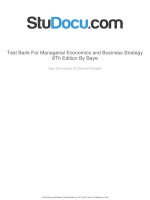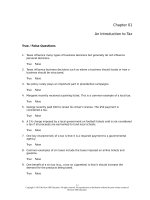Test bank taxation of individuals and business entities 2015 6e by brian c spilker chap003
Bạn đang xem bản rút gọn của tài liệu. Xem và tải ngay bản đầy đủ của tài liệu tại đây (449.19 KB, 153 trang )
Chapter 03
Tax Planning Strategies and Related Limitations
True / False Questions
1. The goal of tax planning is tax minimization.
True
False
2. Nontax factors do not play an important role in tax planning.
True
False
3. Virtually every transaction involves the taxpayer and two other parties that have an
interest in the tax ramifications of the transaction.
True
False
4. The timing strategy is based on the idea that where income is taxed affects the tax
costs of the income.
True
False
5. In general, tax planners prefer to accelerate deductions.
True
False
6. The concept of present value is an important part of the timing strategy.
True
False
7. Assuming an after-tax rate of return of 10%, John should prefer to pay $85 today
instead of $100 in one year.
True
False
8. The time value of money suggests that $1 in one year is worth less than $1 today.
True
False
9. The present value concept becomes more important as interest rates increase.
True
False
10. Future value can be computed as Future Value = Present Value/(1 + r) n.
True
False
3-1
Copyright © 2015 McGraw-Hill Education. All rights reserved. No reproduction or distribution without the prior written consent of
McGraw-Hill Education.
11. When considering cash inflows, higher present values are preferred.
True
False
12. When considering cash outflows, higher present values are preferred.
True
False
13. Tax savings generated from deductions are considered cash inflows.
True
False
14. In general, tax planners prefer to defer income. This is an example of the conversion
strategy.
True
False
15. The timing strategy is particularly effective for cash basis taxpayers.
True
False
16. The timing strategy becomes more attractive as tax rates decrease.
True
False
17. The timing strategy becomes more attractive as interest rates (i.e., rates of return)
increase.
True
False
18. The timing strategy becomes more attractive if a taxpayer is able to accelerate
deductions by two or more years (versus one year).
True
False
19. One limitation of the timing strategy is the difficulties in accelerating a tax deduction
without accelerating the actual cash outflow that generates the tax deduction.
True
False
20. The constructive receipt doctrine is a natural limitation for the conversion strategy.
True
False
21. The constructive receipt doctrine is more of an issue for cash basis taxpayers.
True
False
22. If tax rates will be higher next year, taxpayers should accelerate their deductions
regardless of their after-tax rate of return.
True
False
3-2
Copyright © 2015 McGraw-Hill Education. All rights reserved. No reproduction or distribution without the prior written consent of
McGraw-Hill Education.
23. If tax rates will be lower next year, taxpayers should accelerate their deductions
regardless of their after-tax rate of return.
True
False
24. If tax rates will be higher next year, taxpayers should defer their income to next year
regardless of their after-tax rate of return.
True
False
25. The value of a tax deduction is higher for a taxpayer with a lower tax rate.
True
False
26. The income shifting strategy requires taxpayers with varying tax rates.
True
False
27. The assignment of income doctrine is a natural limitation to the timing strategy.
True
False
28. The business purpose, step-transaction, and substance-over-form doctrines may limit
the income shifting strategy.
True
False
29. Paying dividends to shareholders is one effective way of shifting income from a
corporation to its shareholders.
True
False
30. The conversion strategy capitalizes on the fact that tax rates vary across different
activities.
True
False
31. Implicit taxes may reduce the benefits of the conversion strategy.
True
False
32. The business purpose, step transaction, and substance over form doctrines may limit
the conversion strategy.
True
False
33. Tax avoidance is a legal activity that forms the basis of the basic tax planning
strategies discussed in class.
True
False
34. Tax evasion is a legal activity that forms the basis of the basic tax planning strategies
discussed in class.
True
False
3-3
Copyright © 2015 McGraw-Hill Education. All rights reserved. No reproduction or distribution without the prior written consent of
McGraw-Hill Education.
35. The rewards of tax avoidance include stiff monetary penalties and imprisonment.
True
False
Multiple Choice Questions
36. The goal of tax planning generally is to:
A.
B.
C.
D.
E.
Minimize IRS scrutiny
Maximize after-tax wealth
Support the Federal government
37. Effective tax planning does not require consideration of:
A.
B.
C.
D.
E.
the taxpayer's tax costs of alternative transactions
the other party's tax costs of alternative transactions
the other party's nontax costs of alternative transactions
38. Which is not a basic tax planning strategy?
A.
B.
C.
D.
E.
arms length transaction
39. Which of the following strategies is based on the present value of money?
A.
B.
C.
D.
E.
3-4
Copyright © 2015 McGraw-Hill Education. All rights reserved. No reproduction or distribution without the prior written consent of
McGraw-Hill Education.
40. Assuming a positive interest rate, the present value of money suggests:
A.
B.
C.
D.
E.
$1 today = $1 in one year
$1 today > $1 in one year
$1 today < $1 in one year
$1 today <= $1 in one year
41. If Joel earns a 10% after-tax rate of return, $10,000 received in two years is worth
how much today (rounded)?
A.
B.
C.
D.
E.
42. If Lucy earns a 6% after-tax rate of return, $8,000 received in four years is worth how
much today?
A.
B.
C.
D.
E.
43. If Nicolai earns an 8% after-tax rate of return, $20,000 today would be worth how
much to Nicolai in 5 years?
A.
B.
C.
D.
E.
44. If Scott earns a 12% after-tax rate of return, $15,000 today would be worth how much
to Scott in 2 years?
A.
B.
C.
D.
E.
3-5
Copyright © 2015 McGraw-Hill Education. All rights reserved. No reproduction or distribution without the prior written consent of
McGraw-Hill Education.
45. If Rudy has a 25% tax rate and a 6% after-tax rate of return, a $30,000 tax deduction
in four years will save how much tax in today's dollars (rounded)?
A.
B.
C.
D.
E.
46. If Julius has a 30% tax rate and a 10% after-tax rate of return, a $40,000 tax
deduction in two years will save how much tax in today's dollars (rounded)?
A.
B.
C.
D.
E.
47. If Thomas has a 40% tax rate and a 6% after-tax rate of return, $50,000 of income in
five years will cost him how much tax in today's dollars (rounded)?
A.
B.
C.
D.
E.
48. If Julius has a 20% tax rate and a 10% after-tax rate of return, $25,000 of income in
three years will cost him how much tax in today's dollars (rounded)?
A.
B.
C.
D.
E.
49. Which of the following increases the benefits of income deferral?
A.
B.
C.
D.
E.
increasing tax rates
smaller after-tax rate of return
larger after-tax rate of return
smaller magnitude of transactions
3-6
Copyright © 2015 McGraw-Hill Education. All rights reserved. No reproduction or distribution without the prior written consent of
McGraw-Hill Education.
50. Which of the following decreases the benefits of accelerating deductions?
A.
B.
C.
D.
E.
decreasing tax rates
smaller after-tax rate of return
larger after-tax rate of return
larger magnitude of transactions
51. Which of the following does not limit the benefits of deferring income?
A.
B.
C.
D.
E.
increasing tax rates
a taxpayer with severe cash flow needs
if continuing an investment would generate a low rate of return
if continuing an investment would subject the taxpayer to unnecessary risk
52. The constructive receipt doctrine:
A.
B.
C.
D.
E.
is particularly restrictive for accrual basis taxpayers
causes income to be recognized before it is actually received
causes income to be recognized after it is actually received
applies equally to income and expenses
53. Rolando's employer pays year-end bonuses each year on December 31. Rolando, a
cash basis taxpayer, would prefer to not pay tax on his bonus this year. So, he leaves
town on December 31, 2014 and doesn't pick up his check until January 2 nd, 2015.
When should Rolando report his bonus?
A.
B.
C.
D.
E.
Rolando can choose the year to report the income
54. If tax rates are decreasing:
A.
B.
C.
D.
E.
taxpayers should accelerate income
taxpayers should defer deductions
taxpayers should defer income
taxpayers should defer deductions and accelerate income
3-7
Copyright © 2015 McGraw-Hill Education. All rights reserved. No reproduction or distribution without the prior written consent of
McGraw-Hill Education.
55. If tax rates are decreasing:
A.
B.
C.
D.
E.
taxpayers should accelerate income
taxpayers should defer deductions
taxpayers should accelerate deductions
taxpayers should defer deductions and accelerate income
56. If tax rates are increasing:
A.
B.
C.
D.
E.
taxpayers should accelerate income
taxpayers should defer deductions
taxpayers should defer income
you need more information to make a recommendation
57. Which of the following is not required to determine the best timing strategy?
A.
B.
C.
D.
E.
the taxpayer's after-tax rate of return
the taxpayer's tax rate this year
the taxpayer's tax rate in future years
the taxpayer's tax rate last year
58. Which of the following is an example of the timing strategy?
A.
B.
C.
D.
E.
A corporation paying its shareholders a $20,000 dividend
A parent employing her child in the family business
A taxpayer gifting stock to his children
A cash-basis business delaying billing its customers until after year end
59. Which of the following is an example of the timing strategy?
A.
B.
C.
D.
E.
A cash basis taxpayer paying all outstanding bills by year end
A parent employing her child in the family business
A business paying its owner a $30,000 salary
A taxpayer investing in a tax preferred investment
3-8
Copyright © 2015 McGraw-Hill Education. All rights reserved. No reproduction or distribution without the prior written consent of
McGraw-Hill Education.
60. Which of the following does not limit the income shifting strategy?
A.
B.
C.
D.
E.
assignment of income doctrine
business purpose doctrine
substance-over-form doctrine
step-transaction doctrine
61. A taxpayer paying his 10 year old daughter $50,000 a year for consulting likely
violates which doctrine?
A.
B.
C.
D.
E.
constructive receipt doctrine
implicit tax doctrin
substance-over-form doctrine
step-transaction doctrine
62. A taxpayer instructing her son to collect rent checks for the taxpayer's property and
to report this as taxable income on the son's tax return violates which doctrine?
A.
B.
C.
D.
E.
constructive receipt doctrine
implicit tax doctrin
assignment of income doctrine
step-transaction doctrine
63. Which of the following is needed to implement the income shifting strategy?
A.
B.
C.
D.
E.
taxpayers with varying tax rates
decreasing tax rates
increasing tax ra
unrelated taxpaye
64. A common income shifting strategy is to:
A.
B.
C.
D.
E.
shift income from low tax rate taxpayers to high tax rate taxpayers
shift deductions from low tax rate taxpayers to high tax rate taxpayers
shift deductions from high tax rate taxpayers to low tax rate taxpayers
accelerate tax deductions
3-9
Copyright © 2015 McGraw-Hill Education. All rights reserved. No reproduction or distribution without the prior written consent of
McGraw-Hill Education.
65. Jason's employer pays year-end bonuses each year on December 31. Jason, a cash
basis taxpayer, would prefer to not pay tax on his bonus this year (and actually would
prefer his daughter to pay tax on the bonus). So, he leaves town on December 31,
2014 and has his daughter, Julie, pick up his check on January 2 nd, 2015. Who reports
the income and when?
A.
B.
C.
D.
E.
66. Which of the following is more likely to receive IRS scrutiny under the assignment of
income doctrine?
A.
B.
C.
D.
E.
A corporation paying its shareholders a $20,000 dividend
A parent employing her child in the family business
A taxpayer gifting stock to his children
A cash-basis business delaying billing its customers until after year end
67. Which of the following is an example of the income shifting strategy?
A.
B.
C.
D.
E.
A corporation paying its shareholders a $20,000 dividend
A corporation paying its owner a $20,000 salary
A high tax rate taxpayer investing in tax exempt municipal bonds
A cash-basis business delaying billing its customers until after year end
68. Which of the following is an example of the conversion strategy?
A.
B.
C.
D.
E.
A corporation paying its shareholders a $20,000 dividend
A corporation paying its owner a $20,000 salary
A high tax rate taxpayer investing in tax exempt municipal bonds
A cash-basis business delaying billing its customers until after year end
69. Which of the following may limit the conversion strategy?
A.
B.
C.
D.
E.
assignment of income doctrine
constructive receipt doctrine
activities with preferential tax rates
3-10
Copyright © 2015 McGraw-Hill Education. All rights reserved. No reproduction or distribution without the prior written consent of
McGraw-Hill Education.
70. Assume that Bill's marginal tax rate is 30%. If corporate bonds pay 8% interest, what
interest rate would a municipal bond have to offer for Bill to be indifferent between
the two bonds?
A.
B.
C.
D.
E.
71. Assume that John's marginal tax rate is 40%. If a city of Austin bond pays 6%
interest, what interest rate would a corporate bond have to offer for John to be
indifferent between the two bonds?
A.
B.
C.
D.
E.
72. Assume that Larry's marginal tax rate is 25%. If corporate bonds pay 10% interest,
what interest rate would a municipal bond have to offer for Larry to be indifferent
between the two bonds?
A.
B.
C.
D.
E.
73. Assume that Lavonia's marginal tax rate is 20%. If a city of Tampa bond pays 5%
interest, what interest rate would a corporate bond have to offer for Lavonia to be
indifferent between the two bonds?
A.
B.
C.
D.
E.
3-11
Copyright © 2015 McGraw-Hill Education. All rights reserved. No reproduction or distribution without the prior written consent of
McGraw-Hill Education.
74. Assume that Marsha is indifferent between investing in a city of Destin bond that
pays 6% interest and a corporate bond that pays 8% interest. What is Marsha's
marginal tax rate?
A.
B.
C.
D.
E.
75. Assume that Javier is indifferent between investing in a city of El Paso bond that pays
5% interest and a corporate bond that pays 6.25% interest. What is Javier's marginal
tax rate?
A.
B.
C.
D.
E.
76. Assume that Lucas' marginal tax rate is 30% and his tax rate on dividends is 15%. If a
dividend-paying stock (with no growth potential) pays an 8% dividend yield, what
interest rate would a municipal bond have to offer for Lucas to be indifferent between
the two investments?
A.
B.
C.
D.
E.
77. Assume that Keisha's marginal tax rate is 40% and her tax rate on dividends is 15%.
If a city of Atlanta bond pays 7.65% interest, what dividend yield would a dividendpaying stock (with no growth potential) have to offer for Keisha to be indifferent
between the two investments?
A.
B.
C.
D.
E.
3-12
Copyright © 2015 McGraw-Hill Education. All rights reserved. No reproduction or distribution without the prior written consent of
McGraw-Hill Education.
78. Assume that Shavonne's marginal tax rate is 50% and her tax rate on dividends is
15%. If a corporate bond pays 10.2% interest, what dividend yield would a dividendpaying stock (with no growth potential) have to offer for Shavonne to be indifferent
between the two investments?
A.
B.
C.
D.
E.
79. Assume that Will's marginal tax rate is 32% and his tax rate on dividends is 15%. If a
dividend-paying stock (with no growth potential) pays a dividend yield of 8%, what
interest rate must the corporate bond offer for Will to be indifferent between the two
investments?
A.
B.
C.
D.
E.
80. Assume that Jose is indifferent between investing in a corporate bond that pays 10%
interest and a stock with no growth potential that pays an 8% dividend yield. Assume
that the tax rate on dividends is 15%. What is Jose's marginal tax rate?
A.
B.
C.
D.
E.
81. Assume that Juanita is indifferent between investing in a corporate bond that pays
10.2% interest and a stock with no growth potential that pays a 6% dividend yield.
Assume that the tax rate on dividends is 15%. What is Juanita's marginal tax rate?
A.
B.
C.
D.
E.
3-13
Copyright © 2015 McGraw-Hill Education. All rights reserved. No reproduction or distribution without the prior written consent of
McGraw-Hill Education.
82. The income shifting and timing strategies are examples of:
A.
B.
C.
D.
E.
illegal taxpayer strategies
83. A taxpayer earning income in "cash" and not reporting it as taxable income is an
example of:
A.
B.
C.
D.
E.
84. Investing in municipal bonds to avoid paying tax on interest earned and to earn a
higher after-tax yield is an example of:
A.
B.
C.
D.
E.
85. Paying "fabricated" expenses in high tax rate years is an example of:
A.
B.
C.
D.
E.
Essay Questions
3-14
Copyright © 2015 McGraw-Hill Education. All rights reserved. No reproduction or distribution without the prior written consent of
McGraw-Hill Education.
86. Danny argues that tax accountants suffer from one-mindedness in their attempts at
tax planning (i.e., reducing taxes at all costs). Is Danny's view of tax planning correct
- i.e., does he understand what the goal of tax planning is? Please elaborate.
87. An astute tax student once summarized that many of the tax planning strategies
merely make use of the variation of taxation across different dimensions. Explain why
this is true. Be specific.
88. There are two basic timing-related tax rate strategies. What are they? What is the
intent of each strategy? In which situations do the tax rate and timing strategies
provide conflicting recommendations? What information do you need to determine
the appropriate action?
3-15
Copyright © 2015 McGraw-Hill Education. All rights reserved. No reproduction or distribution without the prior written consent of
McGraw-Hill Education.
89. Based only on the information provided for each scenario, determine whether Eddy or
Scott will benefit more from using the timing strategy and why there will be a benefit
to that person.
a. Eddy has a 40% tax rate. Scott has a 30% tax rate.
b. Eddy and Scott each have a 40% tax rate. Eddy has $10,000 of income that could
be deferred; Scott has $20,000 of income that could be shifted.
c. Eddy and Scott each have a 40% tax rate and $20,000 of income that could be
deferred. Eddy's after-tax rate of return is 8%. Scott's after-tax rate of return is 10%.
d. Eddy and Scott each have a 40% tax rate, $20,000 of income that could be
deferred, and an after-tax rate of return of 10%. Eddy can defer income up to 3 years.
Scott can defer income up to 2 years.
90. Based only on the information provided for each scenario, determine whether Kristi
or Cindy will benefit more from using the timing strategy and why there will be a
benefit to that person.
a. Kristi has a 40% tax rate and can defer $20,000 of income. Cindy has a 30% tax
rate and can defer $30,000 of income.
b. Kristy has a 30% tax rate, a 10% after-tax rate of return, and can defer $25,000 of
income for three years. Cindy has a 40% tax rate, an 8% after-tax rate of return, and
can defer $20,000 of income for four years.
3-16
Copyright © 2015 McGraw-Hill Education. All rights reserved. No reproduction or distribution without the prior written consent of
McGraw-Hill Education.
91. David, an attorney and cash basis taxpayer, is new to the concept of tax planning
and recently learned of the timing strategy. To implement the timing strategy, David
plans to establish a new policy that allows his clients to wait up to five years to pay
their attorney fees. Assume that David expects his marginal tax rates to remain
constant over the foreseeable future. What is wrong with this strategy?
92. Explain why $1 today is not equal to $1 in the future. Why is understanding this
concept particularly important for tax planning? What tax strategy exploits this
concept?
93. Luther was very excited to hear about the potential tax savings from shifting income
from his corporation to him. The next day he had his corporation declare a $30,000
dividend to him. Is this an effective income shifting strategy? If so, why? If not, why
not? What recommendations do you have for Luther?
3-17
Copyright © 2015 McGraw-Hill Education. All rights reserved. No reproduction or distribution without the prior written consent of
McGraw-Hill Education.
94. Compare and contrast the constructive receipt doctrine and the assignment of
income doctrine.
In what situations do these doctrines apply? What tax planning strategies does each
doctrine limit?
95. Lucinda is contemplating a long range planning strategy that will allow her to defer
sizable portions of her income for 10 years. What type of planning strategy is she
contemplating? What are some potential risks associated with this type of strategy?
96. Jared, a tax novice, has recently learned of several foreign tax havens (i.e., countries
with low tax rates). He is considering locating his manufacturing operations in one of
these countries solely based on their low tax rates. What types of taxes is Jared
ignoring? Explain how these other taxes may affect the viability of Jared's choice to
locate in a foreign tax haven.
3-18
Copyright © 2015 McGraw-Hill Education. All rights reserved. No reproduction or distribution without the prior written consent of
McGraw-Hill Education.
97. Richard recently received $10,000 of compensation for some consulting work (paid in
cash). Jeffrey recently received $10,000 of interest income from City of Dallas bonds.
Both taxpayers report no taxable income from these transactions. Is this considered
tax avoidance or tax evasion? What is the difference, if any, between the two?
98. Antonella works for a company that pays a year-end bonus in December of each year.
Assume that Antonella expects to receive a $20,000 bonus in December this year,
her tax rate is 30%, and her after-tax rate of return is 8%. If Antonella's employer
paid her bonus on January 1 of next year instead of December, how much would this
action save Antonella in today's tax dollars? If Antonella's tax rate increased to 32%
next year, would receiving the bonus in January still be advantageous?
99. Joe Harry, a cash basis taxpayer, owes $20,000 in tax deductible accounting fees for
his business. Assume that it is December 28 and that Joe Harry can avoid any finance
charges if he pays the accounting fees by January 10 th. Joe Harry's tax rate this year
is 30%. His tax rate next year will be 33%. His after-tax rate of return is 8%. When
should Joe Harry pay the $20,000 fees and why?
3-19
Copyright © 2015 McGraw-Hill Education. All rights reserved. No reproduction or distribution without the prior written consent of
McGraw-Hill Education.
100 Rodney, a cash basis taxpayer, owes $40,000 in tax deductible consulting fees for his
.
business. Assume that it is December 28 and that Rodney can avoid any finance
charges if he pays the accounting fees by January 10 th. Rodney's tax rate this year is
30% and his after-tax rate of return is 10%. At what tax rate next year, will Rodney
be indifferent between paying the $40,000 this year and next year?
101 Troy is not a very astute investor. He has a knack for investing in losing stocks. In his
.
latest investment move, he has realized a loss of about $40,000 (original basis of
$50,000; current fair market value of $10,000) in High Tech, Inc. The good news is
that unlike prior years, he actually has $45,000 of gains that he can use to offset the
loss. Troy is considering either selling the High Tech, Inc. stock to his sister, Louise, or
on the stock market. Which should he choose and why? Please explain why the IRS
may treat the two transactions differently.
3-20
Copyright © 2015 McGraw-Hill Education. All rights reserved. No reproduction or distribution without the prior written consent of
McGraw-Hill Education.
102 O'Reilly is a masterful lottery player. The megamillion jackpot is now up to $200
.
million. If O'Reilly wins the jackpot, he has a choice of receiving $200 million in 5
years or a smaller lump sum currently. Advise O'Reilly on his choice under the
following scenarios. Which option should he take and why?
a. O'Reilly's after tax return is 10%. If he chooses the current lump sum option, the
lottery will pay him $130 million.
b. O'Reilly's after-tax return is 10%. His current tax rate will be 35% if he receives the
lottery payment now. His expected tax rate in five years will be 40%. If he chooses
the current lump sum option, the lottery will pay him $100 million.
103 Sal, a calendar year taxpayer, uses the cash-basis method of accounting for his sole
.
proprietorship. In late December he performed $40,000 of consulting services for a
client. Sal typically requires his clients to pay his bills immediately upon receipt.
Assume that Sal's marginal tax rate is 30% this year and 35% next year and that he
can earn an after-tax rate of return of 12% on his investments. Should Sal send his
client the bill in December or January?
3-21
Copyright © 2015 McGraw-Hill Education. All rights reserved. No reproduction or distribution without the prior written consent of
McGraw-Hill Education.
104 Lucky owns a maid service that cleans several local businesses nightly. Lucky, a high.
tax rate taxpayer, would like to shift some income to his son Rocco. Lucky tells all of
his customers (who are always timely in their payments) to pay Rocco and then
Rocco will report 50% of the income as a collection fee. Lucky will report the
remaining 50%. Will this shift the income from Lucky to Rocco? Why or why not?
What doctrines influence your answer? Any suggestions for Lucky?
105 Bono owns and operates a sole proprietorship and has a 30% marginal tax rate. He
.
provides his son, Richie, $12,000 a year for college expenses. Richie, works as a
street musician and has a marginal tax rate of 15%. What could Bono do to reduce
his family tax burden? How much pre-tax income does it currently take Bono to
generate the $12,000 after-taxes given to Richie? If Richie worked for his father's
sole proprietorship, what salary would Bono have to pay him to generate $12,000
after taxes? (Ignore any Social Security, Medicare, or Self Employment Tax issues.)
How much money would this strategy save?
3-22
Copyright © 2015 McGraw-Hill Education. All rights reserved. No reproduction or distribution without the prior written consent of
McGraw-Hill Education.
106 Jayzee is a single taxpayer who operates a sole proprietorship. He expects his
.
taxable income next year to be $150,000, of which $125,000 is attributed to his sole
proprietorship. Jayzee is contemplating incorporating his sole proprietorship. Using
the 2014 single individual tax brackets and the corporate tax brackets, how much
current tax could this strategy save Jayzee? (Ignore any Social Security, Medicare, or
Self Employment Tax issues.) How much income should be retained in the
corporation?
107 Bobby and Whitney are husband and wife and Whitney operates a sole
.
proprietorship. They expect their joint taxable income next year to be $200,000, of
which $125,000 is attributed to the sole proprietorship. Whitney is contemplating
incorporating the sole proprietorship. Using the 2014 married filing joint tax brackets
and the corporate tax brackets, how much current tax could this strategy save Bobby
and Whitney? How much income should be retained in the corporation?
108 Rob is currently considering investing in municipal bonds that earn 4% interest or
.
taxable bonds issued by Dell Computer that pay 6.5%. If Rob's tax rate is 20%, which
bond should he choose? Which bond should he choose if his tax rate is 30%? At what
tax rate would he be indifferent to the municipal bond or to the corporate bond?
What strategy is this decision based upon?
3-23
Copyright © 2015 McGraw-Hill Education. All rights reserved. No reproduction or distribution without the prior written consent of
McGraw-Hill Education.
109 Maurice is currently considering investing in a high dividend yield stock with no
.
growth potential that pays a 6% dividend yield or bonds issued by The Coca Cola
Company that pay 8%. If Maurice's ordinary tax rate is 25% and his dividend tax rate
is 15%, which investment should he choose? Which investment should he choose if
his ordinary tax rate is 30%? At what ordinary tax rate would he be indifferent to the
stock or to the bond? What strategy is this decision based upon?
110 Boeing is considering opening a plant in two neighboring states. One state has a
.
corporate tax rate of 15%. If operated in this state, the plant is expected to generate
$1,200,000 pre-tax profit. The other state has a corporate tax rate of 5%. If operated
in this state, the plant is expected to generate $1,085,000 of pre-tax profit. Which
state should Boeing choose? Why do you think the plant in the state with a lower tax
rate would produce a lower pre-tax income?
3-24
Copyright © 2015 McGraw-Hill Education. All rights reserved. No reproduction or distribution without the prior written consent of
McGraw-Hill Education.
Chapter 03 Tax Planning Strategies and Related Limitations
Answer Key
True / False Questions
1.
The goal of tax planning is tax minimization.
FALSE
The goal of tax planning is the maximization of after-tax wealth while achieving
the taxpayer's nontax goals.
AACSB: Reflective Thinking
AICPA: BB Critical Thinking
Accessibility: Keyboard Navigation
Blooms: Analyze
Learning Objective: 03-01 Identify the objectives of basic tax planning strategies.
Level of Difficulty: 1 Easy
Topic: Basic tax planning overview
2.
Nontax factors do not play an important role in tax planning.
FALSE
AACSB: Reflective Thinking
AICPA: BB Critical Thinking
Accessibility: Keyboard Navigation
Blooms: Analyze
Learning Objective: 03-01 Identify the objectives of basic tax planning strategies.
Level of Difficulty: 1 Easy
Topic: Basic tax planning overview
3.
Virtually every transaction involves the taxpayer and two other parties that have
an interest in the tax ramifications of the transaction.
TRUE
AACSB: Reflective Thinking
AICPA: BB Critical Thinking
Accessibility: Keyboard Navigation
Blooms: Analyze
Learning Objective: 03-01 Identify the objectives of basic tax planning strategies.
Level of Difficulty: 2 Medium
Topic: Basic tax planning overview
3-25
Copyright © 2015 McGraw-Hill Education. All rights reserved. No reproduction or distribution without the prior written consent of
McGraw-Hill Education.
